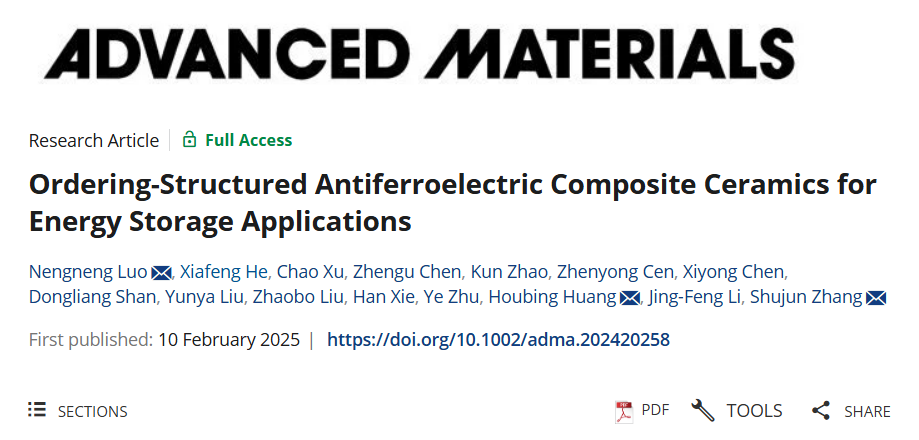Recently, a research team from the School of Resources, Environment and Materials at GXU has achieved a breakthrough in alumina-reinforced composite dielectric energy storage ceramics. The findings, titled "Ordering-Structured Antiferroelectric Composite Ceramics for Energy Storage Applications", were published in Advanced Materials, a top-tier international journal. Professor Luo Nengneng from the School of Resources, Environment and Materials and Ph.D. He Xiafeng from the School of Physical Science and Technology served as the first author and corresponding author, respectively. Co-corresponding authors included Professor Huang Houbing from Beijing Institute of Technology and Professor Zhang Shujun from the University of Wollongong, Australia. Collaborating institutions also involved Tsinghua University, Harbin Institute of Technology, Hong Kong Polytechnic University, and Xiangtan University.

With rapid development of electronic technologies and devices, dielectric capacitors for pulsed power applications urgently need miniaturization and integration, demanding higher energy storage density in dielectric materials. Antiferroelectric materials, characterized by double hysteresis loops, high polarization intensity, and near-zero remnant polarization, are promising candidates for dielectric capacitors. However, their limited breakdown strength restricts their practical energy storage performance.
To address this challenge, inspired by the natural nacre structure, the team proposed an innovative strategy to enhance breakdown strength and energy storage density by constructing an ordered nacre-like micro-structure. They introduced high-breakdown-strength alumina (Al₂O₃) platelet templates into an antiferroelectric ceramic matrix and aligned them parallel via tape-casting technology, creating an "ordering-structured" antiferroelectric composite ceramic. The study revealed that the aligned Al₂O₃ platelets effectively hindered charge migration and electrical treeing propagation, increasing the composite's breakdown strength by 1.5 times. This unique microstructure enabled an ultrahigh energy storage density of 13.2 J/cm³, significantly surpassing conventional ceramics. The research provides a novel approach for designing high-performance dielectric ceramics for energy storage capacitors.

Guangxi possesses abundant aluminum resources, and it is a critical research goal to make good use of them. This study demonstrates that alumina as a reinforcing phase significantly improves energy storage density in dielectric materials, potentially expanding its applications in high-end capacitors. It opens new avenues for the high-value utilization of Guangxi’s aluminum resources.
The research was supported by the National Natural Science Foundation of China, Guangxi Outstanding Youth Foundation, Guangxi Bagui Young Scholars Program, and key laboratory platforms at national and regional levels.